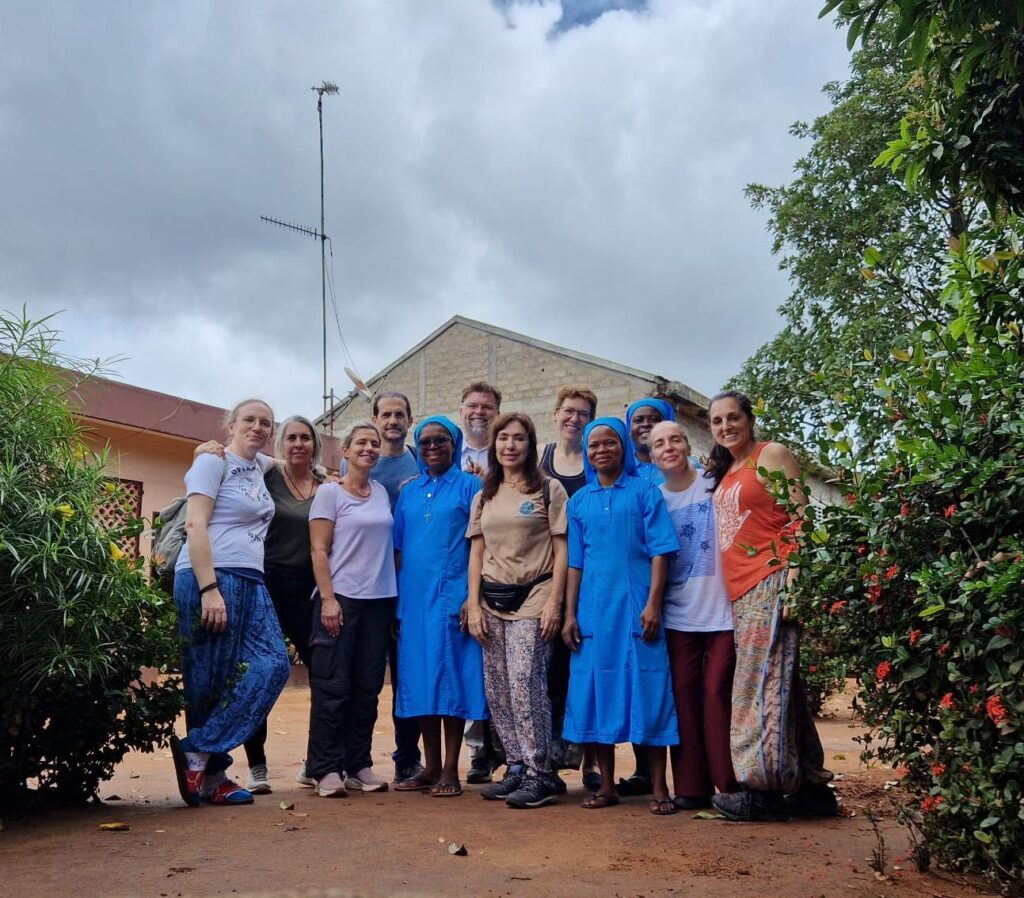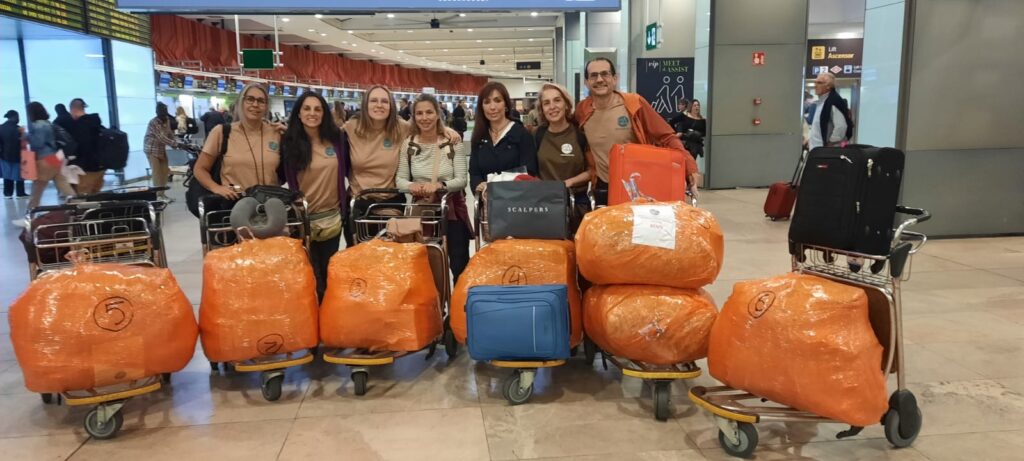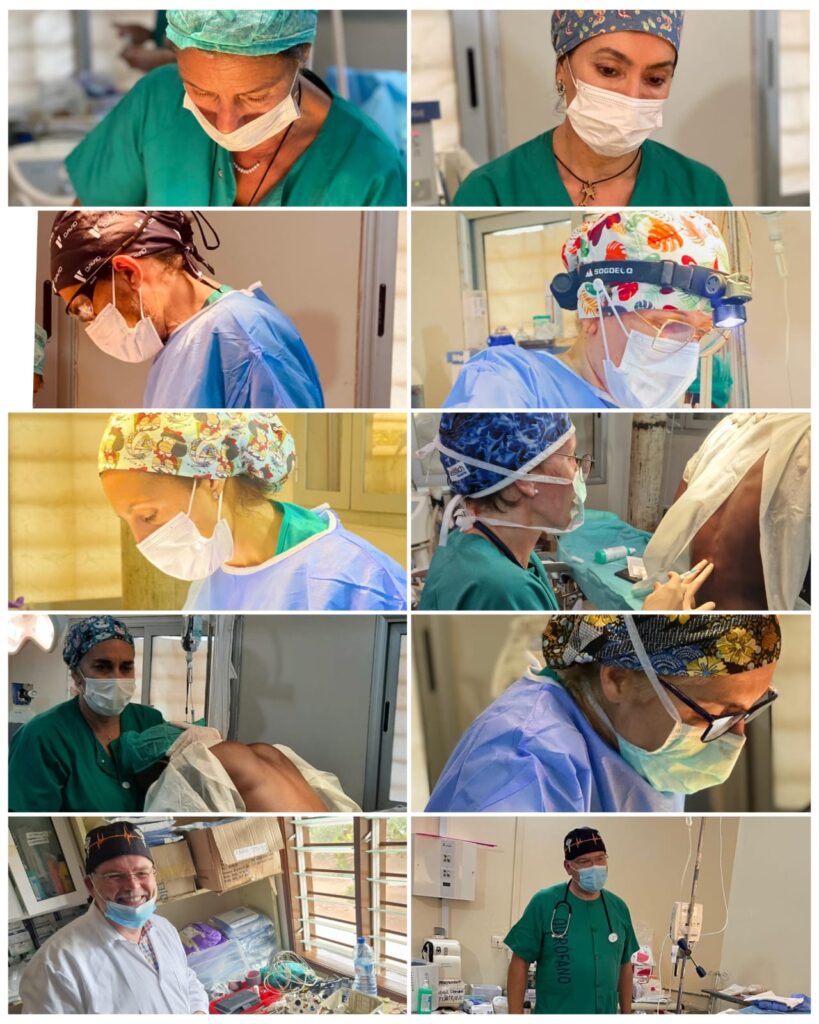
CAMPAIGN: BENIN. DANGBO. HOPITAL ALBERGUE D’AMOUR REDEMTOUR.

DATE: 28 SEPTEMBER TO 6 OCTOBER 2024.
Content
TECHNICAL REPORT: 1
DATES AND LOGISTICS DEPLOYED: 1 ADULT PATIENTS: 2
PAEDIATRIC PATIENTS: 2
Total procedures 2 Total patents 2 COMPLICATIONS: 2 CAMPAIGN REPORT 3 THE PLACE 3
THE TEAM 3
THE LOCAL STAFF 4 THE EQUIPMENT 4 ANAESTHESIA 5
ASEPSIS AND SURGICAL MATERIAL 5 OUR LIFE AT DANGBO 6 CONCLUSION 7
- Strengths of this place: 7
- ObjecAves for improvement: 7 BUDGET: (small breakdown of costs) 8
- COST PER PARTICIPANT: 8
- TOTAL COST OF THE CAMPAIGN: 8 SIGNATURES 8
| 1. TECHNICAL REPORT: |
1. DATES AND LOGISTICS DEPLOYED:
The Surgeons in Action Foundation (SAF) has deployed a team of 9 volunteers to carry out a campaign in Benin, at the Hopital Albergue d’Amour Redemptour in Dangbo.
We had 7 members from Madrid and 2 from Zurich on the 28th of September 2024, meeting in Paris. In total, we have transported 200kg of medical material for the campaign, including 23 medicines with export authorisation no. 37587/24 from the AEMPS.
The journey to Dango is reasonably good. The flight, with Air France, via Paris, takes about 10-12 hours depending on the connection. From the airport to Dangbo it is about 2 hours by car, which we have in two vans organised by Sister Opportune.

It is important to note the issue of luggage. Air France allows a 23kg baggage allowance. They are strict about the weight, and, more importantly, they have been quite strict about the weight. importantly, they gave us a lot of trouble in Cotonou to check in some of the bags we were bringing (electrodiathermy and harmonic generator). For future SAF campaigns, I think it is important to stop carrying ‘Chinese’ bags, which are becoming more and more problematic at airports and the airlines do not allow us to check them in. They will have to be replaced by more robust travel cardboard boxes.
We worked at the hospital from 29 September to 5 October inclusive.
The return trip to Madrid and Zurich took place on 6 October 2024.
80 surgical procedures have been performed on 75 patients. An excel file with the complete database is ajached.

Breakdown by pathology: 10 total thyroidectomies 16 hemithyroidectomies
37 inguinal hernioplasties (Lichtenstein), 4 of them bilateral. 3 midline hernias (Rives)
1 umbilical hernia (preperitoneal hernioplasty)
1 bilateral and 1 unilateral hydrocele (hydrocelectomy). 6 soft tissue tumours.
- PAEDIATRIC PATIENTS:
No paediatric patints were treated in this campaign.
- Total procedures
80
- Total paJents
75
- COMPLICATIONS:
1 patient with immediate surgical reoperation for cervical haematoma. The patient developed a cervical haematoma during anaesthetic awakening. Reintubation, exploration of the surgical field, and haemostasis were performed without further incident.
- patient had an intraoperative haemorrhage of about 700cc during a difficult total thyroidectomy. The postoperative course was unevenful.
- patients with inguinal hernioplasty developed a haematoma in the surgical wound, which was treated conservatively, with good evolution after our departure.
| 2. CAMPAIGN REPORT |
- THE PLACE
Hopital Albergue d’Amour Redemptour in Dangbo is a location that SAF has been very familiar with f many years, regularly conducting campaigns. This hospital, run by Sister Opportune, maintains constant activity of collaboraAon with different organisations, which allows them to carry out surgical campaigns in their hospital on a regular basis. Our campaign was the seventh this year at the centre bringing the total to ten by the end of the year.
Dangbo is a small town in southern Benin, an hour’s drive from the capital, Portonovo, and about ten hours from Cotonou airport. It has a central area, crossed by the dirt road that connects it to the rest the country, where the most important part of the town lives in small buildings. It has a market, which we were only able to visit on Sunday afternoon after work, when it was empty. The rest of the village made up of houses scattered around the countryside.
It has a hotel, the Behova Hotel, where we stayed in reasonable comfort. It has air-conditioned rooms with cold running water. It also has a small restaurant where we had breakfast daily.
The hospital consists of a group of small single-storey buildings within a fenced enclosure.
Our activity has been developed in a small surgical block, which has an operating theatre in which we have arranged two surgical tables. It also has a small cleaning and sterilisation room, a room used for storage, and an entrance that serves as a post-anaesthetic recovery room. The adjoining building houses the hospital wards. In the style of other places in Africa, they are open-plan rooms with bed where patients and their families spend time from the time they arrive unyil they are discharged.
In this area there is also the house where the nuns live in community, which is where we have had a daily lunch and dinner, generously served by them, with impressive affection and dedication.

Another building is used for outpatient consultations. For our campaign, Sister Opportune had previously selected the patients we were going to operate on, with a solvency and organisation that unusual in other locations we work with .It was only necessary to use Sunday morning to consult all the patients and organise the surgical plan for the whole week. All the patients have a small folder with the medical history, with a brief description of their medical history, clinical diagnosis, and medications. Some patients bring an imaging test performed in the capital.
- THE TEAM
The team is made up of 2 nurses, 4 surgeons, 2 anaesthetists and 1 biomedical engineer: David Fernández Luengas: Team coordinator. Surgeon.
Sandra del Barrio Anaya: Surgeon. Ana M Gay Fernández: Surgeon.
Fátima Sánchez-Cabezudo Noguera: Surgeon. Rocío Díez Munar: Anaesthetist.
Katharina Wentkowsky: Anaesthetist. Nuria Agulló Marín: Nurse.
Silvestra Barrena Blázquez: Nurse. Michael Wentkowsky: Engineer.

It is very important to highlight the good atmosphere in which our activity and coexistence has developed. This is undoubtedly due to the enormous human quality of the members of the group, to their great professional training.
The language barrier between Katharina and Michael, volunteers from the NGO Hernia International northern Swiss, German-speaking and fluent in English, and the rest of the Spanish team, has been overcome thanks to the collaboration of all. Michael’s fun and open attitude is very remarkable, as he has constantly encouraged has constantly encouraged the group, favouring that connection, sometimes difficult when the largest part of a group speaks a different language. The collaboration with Hernia International is very important for the SAF, and it is great news that, once again, a joint team has developed a campaign in such a good working atmosphere. I think K&M have learnt more Spanish than we have learnt English!!! Katharina and Rocío worked very well together to perform the general and spinal anaesthesia, and brought a lot of security to the team. All patients have received anaesthetic treatment of the highest quality.
The team of surgeons worked very closely together, in alternating pairs that allowed us to share our work with each other. We have performed some fairly complex procedures in a good atmosphere of collaboration, and we have been very effective in achieving the planned plan of interventions, at a very high pace.
Silve and Nuria have worked very hard in the operating theatre, from organising the material, circulation and instrumentation in the operations, supporting the anaesthetists and taking care of the patients in the pre- and immediate postoperative period.
Michael, a biomedical engineer who always accompanies Katharina on the campaigns, has carried out repairs on several devices in the operating theatre (notably the repair of two monitors for intraoperative control), and has been appointed Celador Jefe of the team, thanks to his great willingness for all the tasks we have asked him to carry out.
- LOCAL STAFF
The daily work on this campaign would not have been as effective if we had not been able to count on the collaboration and hard work throughout the week of the hospital’s local team.

First of all, Sister Opportune, the real heart and soul of the hospital. She has been responsible for the recruitment of patients, and for organising all the activity of the hospital so that we could work at such a high pace.
Her colleagues in the community have taken care of us during the lunches and dinners, which they have prepared for us with great dedication, even late at night, as we have finished several days later than 22h. Our thanks to Nadine for taking such good care of us.
Gavin, the nurse, spent the whole week at the hospital, with full dedication to the operated patients, helping us with dressings, medication and communication with the patients.
Silvie, Filomene, Protector and worked alongside us in the operating theatre, developing a very efficient activity of patient flow, cleaning and sterilisation of material and operating theatre.
This place has many advantages for the realisation of surgical campaigns, but its greatest strength is undoubtedly its human team.
- THE EQUIPMENT
Expendable material: We have used all the material we brought with us, about 200kg. The hospital has a lot of material that has been contributed by previous campaigns, well organised and handy in the warehouse, which we have tried not to use. There are disposable surgical drapes, sutures, various operating theatre materials. There are also cloth pyjamas and clogs which are washed daily.
Surgical equipment: There are 3 electrosurgical units in good working order (Michael did some repair work to get them in good working order). Michael tried to fix a fourth device (Valleylab) but it is beyond repair. In any case, with these three devices, we can work perfectly well.
We also brought an ultrasound generator for the thyroid surgery, loaned by the company Medical Cañada, with enough consumable forceps for all the procedures.
Anaesthesia: We used a Drager Fabius ventilator which had been repaired in the weeks prior to our arrival, and which worked correctly, with no problems. There is no capnograph. There are two vital signs monitors, which Michael managed to repair and get working. We have used portable pulse oximeters brought by us, a portable automatic blood pressure cuff and a portable infusion pump. On the day we were leaving, the new Mindray WATO EX-35 ventilator arrived, which has been funded by the Bisturí Solidario FoundaAon and the Asociación Infancia y Cirugía en Dangbo. It has already been installed and can be used in the coming campaigns. It is a great leap in quality, firstly because it is more modern and complete than the other ventilator, and secondly because it will allow us to have two general anaesthesia stations.

- ANESTHESIA
During the Campaign we performed 26 thyroidectomies under general anaesthesia, with orotracheal intubation, mostly using 7.5 tubes (almost all patients were women). On 4 occasions we used a Mcgraph video laryngoscope, which we carried specifically for this purpose, due to the expected difficulty in the airway. No awake patient was intubated. We did not have capnography or an oxygen sensor, although we did measure volume curves. We had several filters that changed colour on contact with CO2, useful for checking correct intubation in case of doubt.
Approximately half of the cases were performed with Sevorane, there are several bojles there, and the other half with percussion of propofol in an infusion pump that we carry.
We also performed 3 general anaesthetics with a laryngeal mask, for a fibroadenoma and 2 large lipomas.

There were 2 local anaesthesias with sedation for neck lipomas, and the rest of the anaesthesias (44) were spinal, for inguinal, umbilical and epigastric hernias. For the larger, isobar bupivacaine had to be used.
Patients operated under general anaesthesia stay 1-2 hours in the room next to the operating theatre, on a stretcher that allows for some back support (although it is in poor condition) with a pulse oximeter and oxygen when necessary. Silvie and Filomene helped us to keep an eye on them. We took almost all the material we used ourselves, and left what we had left over there. It is worth noting that there is a large amount of hyperbaric bupivacaine and levobupivacaine. We also left about 40 bojles of cefazolin 2g, and 5 bojles of clindamycin 600mg. We left over 20 ampoules of propofol and 10 bojles of 50 ml 2%. The 45 ampoules of fentanyl that we did not use were left with Soster Opportune for safekeeping. As for monitoring, despite Michael’s help with the arrangement of 2 monitors that have EKG, pulse oximetry and blood pressure, more need to be carried. The cuffs are badly damaged and leak or fail constantly. Also, for the patients we left on the stretcher outside, there is no monitoring. We carried 3pulse oximeters and a portable automatic blood pressure cuff which helped us a lot.
- ASEPSIA AND SURGICAL MATERIAL
Instruments: For this campaign we have brought 5 boxes of instruments from the SAFA, two for thyroid and 3 for hernia. We also used instruments available in the hospital, which are in a reasonable state of conservation, although they are very limited. This allowed us to have a quick rotation, which is essential to be able to operate on an average of 15 patients per day.
They have a small autoclave machine (Matachana, modern, in perfect condition), which can hold 2-3 small boxes of instruments. They have another autoclave next to, which they use as a deposit for sterilised material.
The local team constantly washes and sterilises the material, in order to maintain a high rate of replacement. The sterile, disposable operating theatre linen, gowns, sheets and drapes, were brought by us.
- OUR LIFE IN DANGBO
This week in Dangbo has been very intense. We have worked hard, and the whole group has been living together in a very healthy atmosphere. The alarm clock goes off at 7AM. At 7:30AM we are having breakfast in the hotel restaurant. Soluble coffee, tea with lemon, condensed milk, and a plate of omelette with vegetables and a roll of bread. The last few days, they even served us croissants and chocolate breads.
It is a pleasant 10-minute walk to the hospital and the day begins.
On Sunday morning we went to see the patients, and we organised the whole plan on two surgical tables, with about 5-6 patients with goitres on the general anaesthesia table, and about 8-10 patients with wall pathology on the spinal anaesthesia table, each day.
The only ‘down time’ we enjoyed was a walk around town on Sunday afternoon, and a quick visit to the beach on the Cotonou coast on Saturday afternoon, before embarking for home.

From Monday to Friday, our day basically consisted of operating from 8:30-14:30h and 15.30-22H. We stopped for an hour for lunch in the nuns’ dining room, and another hour at the end of the day for dinner. They served us a wonderful meal, salads for starters and a variety of dishes for main courses – they even made a Spanish omelette! And, of course, there was always cold beer, something that could be considered a basic necessity, considering the heat and the risk of dehydration associated with the intense work.
At the end of the day, we went for another night walk back to the hotel. Before falling asleep at around 23:30-24h, we only have time for a wonderful shower with buckets of cold water.
During the working day, it is quite hot inside the operating theatre. The only place where it is more comfortable is in the operating theatre, thanks to two air-conditioning units that run all day long.
All in all, our life in this campaign has been very pleasant, with a good atmosphere, a lot of work, and with the feeling that in Dangbo everything is ‘easy’. We leave with the feeling of having worked hard, of having participated in a great project, Hopital Albergue d’Amour Redemptour, led by Sister Opportune, and with the desire to return again. SAF will not miss its appointment, and I hope that we will be able to carry out more campaigns there next year.

-Local organisation and staff. This is undoubtedly one of the best locations for SAF to work with.
-Recruitment.
-Quietness of the location.
-Short’ travel time from Spain.
3.2. Objectives for improvement:
-I believe that, with the acquisition of the new ventilator, a new room could be set up as an operating theatre for spinal anaesthesia, allowing 3 patients to be operated on at the same time.
-One or two stretchers in the room next to the operating theatre to make the transfer of patients and their stay there during post-anaesthesia recovery more comfortable. At present there is one transfer stretcher with wheels and one stretcher without wheels, with a broken backrest.
-New blood pressure cuffs on the monitors.
-Fix the air-conditioning unit in the operating theatre storeroom.

